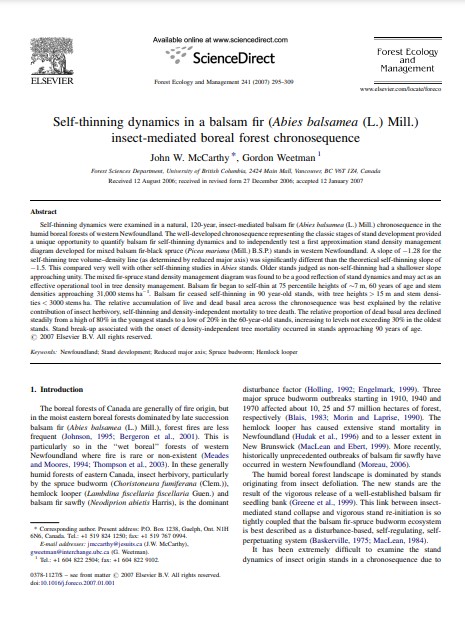Self-thinning dynamics in a balsam fir (Abies balsamea (L.) Mill) insect-mediated boreal forest chronosequence
Bosque Modelo:
Western Newfoundland
Temática:
Conservación
Tipo de documento:
Artículo científico
Resumen
Self-thinning dynamics were examined in a natural, 120-year, insect-mediated balsam fir (Abies balsamea (L.) Mill.) chronosequence in the humid boreal forests of western Newfoundland. The well-developed chronosequence representing the classic stages of stand development provided a unique opportunity to quantify balsam fir self-thinning dynamics and to independently test a first approximation stand density management diagram developed for mixed balsam fir-black spruce (Picea mariana (Mill.) B.S.P.) stands in western Newfoundland. A slope of 1.28 for the self-thinning tree volume–density line (as determined by reduced major axis) was significantly different than the theoretical self-thinning slope of 1.5. This compared very well with other self-thinning studies in Abies stands. Older stands judged as non-self-thinning had a shallower slope approaching unity. The mixed fir-spruce stand density management diagram was found to be a good reflection of stand dynamics and may act as an effective operational tool in tree density management. Balsam fir began to self-thin at 75 percentile heights of 7 m, 60 years of age and stem densities approaching 31,000 stems ha1. Balsam fir ceased self-thinning in 90 year-old stands, with tree heights > 15 m and stem densities < 3000 stems ha. The relative accumulation of live and dead basal area across the chronosequence was best explained by the relative contribution of insect herbivory, self-thinning and density-independent mortality to tree death. The relative proportion of dead basal area declined steadily from a high of 80% in the youngest stands to a low of 20% in the 60-year-old stands, increasing to levels not exceeding 30% in the oldest stands. Stand break-up associated with the onset of density-independent tree mortality occurred in stands approaching 90 years of age. # 2007 Elsevier B.V. All rights reserved.
Información Bibliográfica
Autor:
McCarthy. JW and G Weetman.
Revista:
Forest Ecology and Management
Año:
2007
N°:
-
País :
Canadá
Páginas:
295 - 309
Volumen:
241
Idioma:
Ingles
Palabras claves
Newfoundland; Stand development; Reduced major axis; Spruce budworm; Hemlock looper





